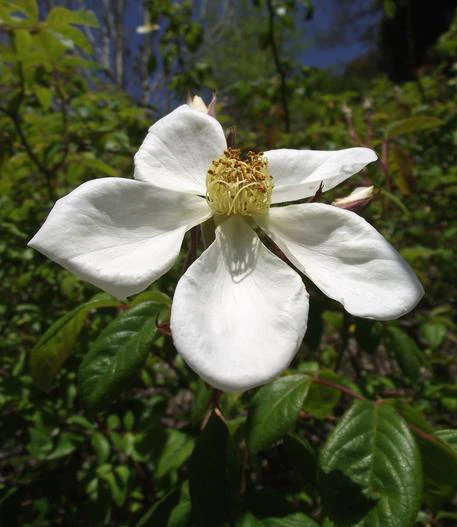Helen’s Rose
(Rosa helenae)
Helen’s Rose (Rosa helenae)
/
/

Stickpen
Public domain
Image By:
Stickpen
Recorded By:
Copyright:
Public domain
Copyright Notice:
Photo by: Stickpen | License Type: Public domain | License URL: https://creativecommons.org/public-domain/ | Uploader: Stickpen | Publisher: Wikipedia Commons







Estimated Native Range
Climate Requirements for Sebring, Florida
| This Plant | Your Site | Plant Suitability for Your Location | ||
|---|---|---|---|---|
| • Precipitation | 5" - 63" | 47" | Aquatic | Aquatic |
| • High Temp. | 50°F - 92°F | 92°F | Your summer temperatures are normal for this plant. | Excellent |
| • Low Temp. | -12°F - 64°F | 50°F | Your winter temperatures are normal for this plant | Excellent |
This plant may not grow well at your location - your precipitation is too high.
Summary
Rosa helenae, commonly known as Helen’s Rose or Fragrant Climbing Rose, is a deciduous climbing shrub native to various habitats in China, including forests, thickets, and slopes. It exhibits a rapid growth rate, reaching heights of 10-20 feet (3-6 meters) and spreading 5-20 feet (1.5-6 meters). This species is characterized by its long, arching canes and its ability to climb if given support. The flowers are typically white or cream, highly fragrant, and bloom profusely in the spring and early summer, creating a visually striking display.
Helen’s Rose is valued for its fragrant, showy flowers and its use as a climbing plant in gardens. It can be trained on trellises, arbors, fences, and other structures to add vertical interest. The plant is relatively easy to maintain, requiring only occasional pruning to keep its growth in check and to remove any dead or diseased wood. It is also used for creating natural screens or as part of a mixed border. Helen’s Rose prefers full sun to part shade and adapts well to a variety of soil types, including clay, loam, and sandy soils, as long as they offer medium drainage. Regular watering is necessary, especially during dry periods. While generally disease-resistant, it can be susceptible to common rose ailments such as black spot and powdery mildew.CC BY-SA 4.0
Helen’s Rose is valued for its fragrant, showy flowers and its use as a climbing plant in gardens. It can be trained on trellises, arbors, fences, and other structures to add vertical interest. The plant is relatively easy to maintain, requiring only occasional pruning to keep its growth in check and to remove any dead or diseased wood. It is also used for creating natural screens or as part of a mixed border. Helen’s Rose prefers full sun to part shade and adapts well to a variety of soil types, including clay, loam, and sandy soils, as long as they offer medium drainage. Regular watering is necessary, especially during dry periods. While generally disease-resistant, it can be susceptible to common rose ailments such as black spot and powdery mildew.CC BY-SA 4.0
Plant Description
- Plant Type: Shrub, Vine
- Height: 10-20 feet
- Width: 5-20 feet
- Growth Rate: Rapid
- Flower Color: Cream, White
- Flowering Season: Spring, Summer
- Leaf Retention: Deciduous
Growth Requirements
- Sun: Full Sun, Part Shade
- Water: Medium
- Drainage: Medium
Common Uses
Bird Garden, Butterfly Garden, Fragrant, Groundcover, Showy Flowers
Natural Habitat
Native to forests, thickets, and slopes in China
Other Names
Common Names: Helen’s Rose, Fragrant Climbing Rose
Scientific Names: Rosa helenae, Rosa floribunda, Rosa helenae f. duplicata, Rosa helenae f. glandulifera, Rosa helenae f. helenae, Rosa moschata var. helenae
GBIF Accepted Name: Rosa helenae